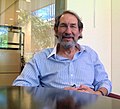Íomhá:Geoffrey West.jpg

Size of this preview: 661 × 600 picteilín. Other resolutions: 264 × 240 picteilín | 529 × 480 picteilín | 846 × 768 picteilín | 1,128 × 1,024 picteilín | 1,322 × 1,200 picteilín.
Taispeáin leagan ardtaifigh den íomhá (1,322 × 1,200 picteilín, méid comhaid: 559 KB, cineál MIME: image/jpeg)
Stair chomhaid
Cliceáil ar dáta/am chun an comhad a radharc mar a bhí sé ag an am sin.
| Dáta/Am | Mionsamhail | Toisí | Úsáideoir | Nóta tráchta | |
|---|---|---|---|---|---|
| faoi láthair | 09:53, 30 Iúil 2007 |  | 1,322 × 1,200 (559 KB) | FlickreviewR | Replacing image by its original image from FlickR |
| 03:44, 30 Iúil 2007 |  | 1,024 × 930 (547 KB) | PDH | {{Information |Description= "As animals get bigger, from tiny shrew to huge blue whale, pulse rates slow down and life spans stretch out longer, conspiring so that the number of heartbeats during an average stay on Earth tends to be roughly the same, arou |
Úsáid comhaid
Níl nasc ó aon leathanach eile don íomhá seo.
Global file usage
The following other wikis use this file:
- Úsáid ar ar.wikipedia.org
- Úsáid ar azb.wikipedia.org
- Úsáid ar de.wikipedia.org
- Úsáid ar en.wikipedia.org
- Úsáid ar en.wikiquote.org
- Úsáid ar fa.wikipedia.org
- Úsáid ar fa.wikiquote.org
- Úsáid ar fr.wikipedia.org
- Úsáid ar gd.wikipedia.org
- Úsáid ar hy.wikipedia.org
- Úsáid ar it.wikipedia.org
- Úsáid ar ja.wikipedia.org
- Úsáid ar ko.wikipedia.org
- Úsáid ar nl.wikipedia.org
- Úsáid ar pa.wikipedia.org
- Úsáid ar pl.wikipedia.org
- Úsáid ar pnb.wikipedia.org
- Úsáid ar sr.wikipedia.org
- Úsáid ar sv.wikipedia.org
- Úsáid ar vi.wikipedia.org
- Úsáid ar zh.wikipedia.org
